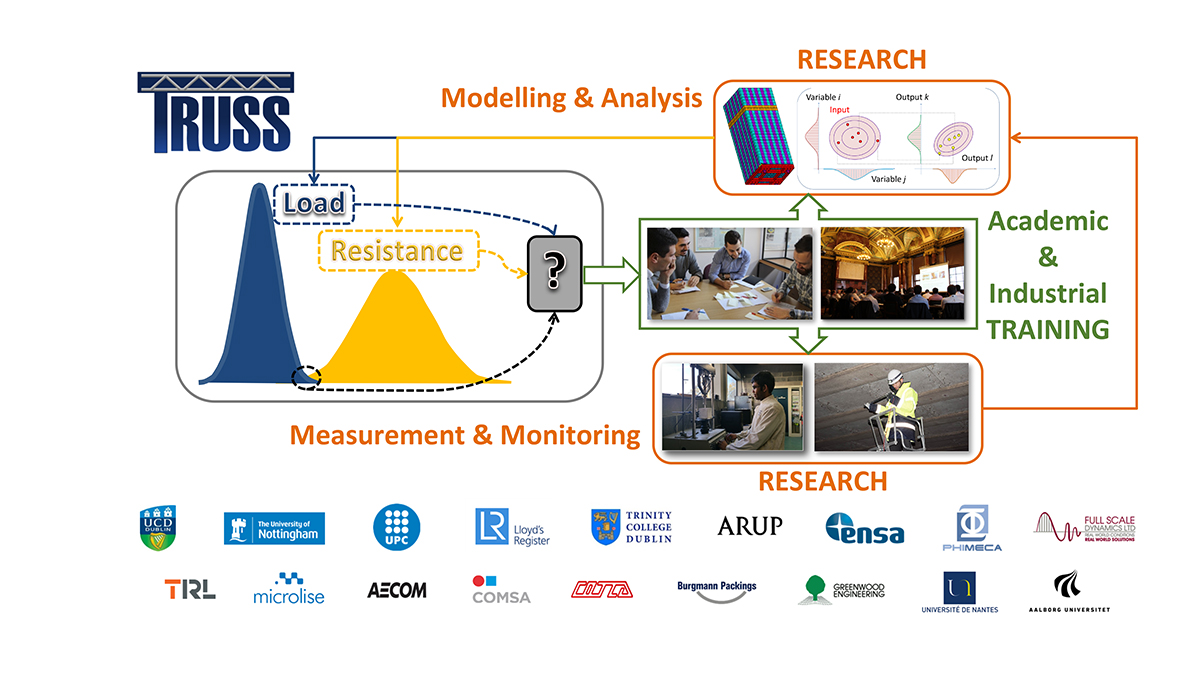Arturo González addresses the need to make infrastructure safer as it continues to experience an increasing rate of deterioration
Some infrastructure is experiencing a fast rate of deterioration as a result of poor design/construction/maintenance or more demanding loads than anticipated, and many buildings, transport, and energy infrastructure are getting close to the ends of their design lives. There is a need for assessing the safety of these structures, i.e., to check that the probability of the structural response falling beyond an established threshold for a given period of time is acceptable. This calculation involves defining a number of input variables that include loading as well as structural properties such as moduli of elasticity, material strength, geometry, boundary conditions, etc.
In a high-level assessment, these variables will be defined by a range of values with a probability of occurrence. Multiple combinations of these input values lead to output responses that become more scatter as the input variables are less well-known, and as the modelling errors increase. Training in Reducing Uncertainty in Structural Safety (TRUSS), is a €3.7 million Marie Skłodowska-Curie Innovative Training Network (ITN) composed by six Universities, 11 companies and 1 research institute from five European countries, joining forces to identify, quantify and reduce uncertainties associated with the probability of structural failure. For this purpose, 14 fellows are recruited to be trained with the right combination of transferable and research-related skills, and to conduct research in specific projects while being exposed to academia and industry, different culture environments, disciplines, and sectors, that will prepare them for dealing with the challenges of an ageing infrastructure stock.
When assessing structural safety, the engineer uses mathematical models consisting of a set of input variables including material properties, load characteristics, environmental effects and geometric dimensions, and a set of derived outputs, i.e., stresses, displacements, damage, etc. There is a degree of uncertainty associated with the models given that they are imperfect idealizations of reality and that their input variables may not be exactly known. Therefore, it is useful to distinguish between epistemic (due to lack of knowledge and data) and aleatory (due to natural random variability) uncertainties. In this way, one can assess how much of the total uncertainty could be potentially further reduced by refining models or by taking more measurements, and how much could be quantified, but cannot be reduced.
There is a degradation of reinforced concrete structures due to corrosion of steel, with global annual costs estimated in around $2.5 trillion. The use of braided Basalt Fiber Reinforced Polymer (BFRP) rebar offers potential performance benefits as it is not subjected to corrosion. However, before designing a structure with BFRP, it is necessary to be fully aware of the inherent uncertainty associated with its mechanical properties. TRUSS quantifies this aleatory uncertainty in a systematic manner, via numerical analysis, tensile and fatigue lab tests, and μCT scanning.
Uncertainties can be inherent to a material property, but they can also be related to the measurement of observations, i.e., the errors in the estimation of in-situ concrete strength with respect to the true strength, introduced by the indirect measurements of a non-destructive test applied to an existing building. This is an epistemic uncertainty that TRUSS aims to reduce via a new screw pull-out testing method that provides better quality data.
Structural geometry can present deviations from the original drawings due to human errors, construction defects or deterioration. For an existing structure, TRUSS reduces this epistemic uncertainty via unmanned aerial vehicles, which are able to overcome difficult-to-access areas and to obtain a full 3D reconstruction at a relatively low cost. This 3D geometry can be imported into a finite element model for structural assessment purposes.
A high-level method of assessment requires to bring measured data into a model by some kind of optimization technique (i.e., finite element updating) to resemble reality. These models can then be used to predict a wider range of future scenarios than those contemplated during the testing or monitoring period, although a degree of uncertainty remains due to modelling errors. The sources of these modelling errors can be both epistemic and aleatory. TRUSS reduces these errors for two highly nonlinear cases, such as the response of a ship unloader to a moving trolley and the response of submerged free-standing nuclear racks subjected to an earthquake, via model refinement with the help of field and lab measurements.
It must be noted that the reduction in uncertainty is limited by a lack of knowledge or data to predict the exact structural behaviour and by the difficulties in increasing the model complexity at the expense of new variables that often cannot be measured. When measuring a structural response, such as strain, for monitoring purposes or for quantifying modelling errors, sensors are traditionally placed only on a few discrete points, typically spaced wide apart to cover a significant portion of the structure. As a result, the response of in-between measurement points is opened to an uncertainty that new developments in distributed optical fibre sensors by TRUSS overcome with high-spatial resolution continuous readings.
Questions arise in infrastructure management on when and how to inspect the structure that TRUSS answers with advanced probabilistic methods, taking the probability of detection of damage, the probability of the evolution of damage, the structural reliability and the life cycle costs into account for assessing fatigue failure in a marine environment. If the mathematical models corresponded to complex structures, the calculation of the remaining life or reliability using Monte Carlo simulation can be computationally very expensive. In order to overcome the latter, TRUSS proposes the far more efficient surrogate models (i.e., kriging). TRUSS also contributes to addressing the uncertainty associated with total life cycle costs in the field of pavements, by building a relationship between fuel consumption and road condition based on field data from vehicle sensors.
With more than one million bridges in Europe, including 100000 railway bridges over 100 years old, recent bridge failures are a sign of a trend that will continue unless the infrastructure is monitored on an ongoing basis. Infrastructure managers need to combine high-level methods of assessment prioritised for key critical infrastructure, with other simpler and faster methods allowing for a preliminary assessment of a major proportion of the infrastructure stock on a frequent basis. TRUSS employs numerical simulations, lab and field tests to investigate the performance of five structural health monitoring methods in establishing whether a bridge has experienced damage (i.e., a stiffness loss) from its response to traffic. These methods are based either on (i) indirect bridge measurements from sensors mounted on a vehicle crossing the bridge, or on (ii) direct measurements from sensors attached to the bridge that, (ii-1) extract vibration-based damage sensitive features, (ii-2) monitor the influence line, (ii-3) update a Bayesian Belief network, and (ii-4) apply bridge weigh-in-motion concepts, with the purpose of damage detection. These monitoring methods provide a preliminary assessment that will be cost effective if they demonstrate that the structure is in good condition, whereas more advanced methods of assessment will be deemed to be necessary in the case of unsatisfactory preliminary results.
The TRUSS ITN project has received funding from the European Union’s Horizon 2020 research and innovation programme under the Marie Skłodowska-Curie grant agreement No. 642453.
Please note: this is a commercial profile
BE, MSc, PhD, ProfDip
Arturo González
Associate Professor
University College Dublin (UCD)
Tel: +353 1 716 3219












